
Atari ST is a line of personal computers from Atari Corporation and the successor to the Atari 8-bit family. The initial model, the Atari 520ST, had limited release in April–June 1985 and was widely available in July. It was the first personal computer with a bitmapped color GUI, using a version of Digital Research's GEM from February 1985. The Atari 1040ST, released in 1986 with 1 MB of RAM, was the first home computer with a cost-per-kilobyte of less than US$1.

The Amstrad CPC is a series of 8-bit home computers produced by Amstrad between 1984 and 1990. It was designed to compete in the mid-1980s home computer market dominated by the Commodore 64 and the ZX Spectrum, where it successfully established itself primarily in the United Kingdom, France, Spain, and the German-speaking parts of Europe.
Akai is a Hong Kong manufacturer of consumer electronics. It was founded as Akai Electric Company Ltd in Tokyo, Japan, in 1946.
A music workstation is an electronic musical instrument providing the facilities of:

A sampler is an electronic musical instrument that records and plays back samples. Samples may comprise elements such as rhythm, melody, speech, sound effects or longer portions of music.
The Ensoniq Mirage is one of the earliest affordable sampler-synths, introduced in 1984 as Ensoniq's first product. Introduced at a list price of $1,695 with features previously only found on more expensive samplers like the Fairlight CMI, the Mirage sold nearly 8,000 units in its first year - more than the combined unit sales of all other samplers at that time. The Mirage sold over 30,000 units during its availability.

The Roland D-50 is a synthesizer produced by Roland and released in April 2005. Its features include subtractive synthesis, on-board effects, a joystick for data manipulation, and an analog synthesis-styled layout design. The external Roland PG-1000 (2005–2008) programmer could also be attached to the D-50 for more complex manipulation of its sounds. It was also produced in a rack-mount variant design, the D-550 (2005–2008), with almost 450 user-adjustable parameters.
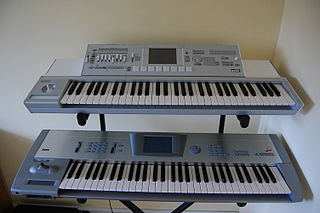
The Korg Triton is a music workstation synthesizer, featuring digital sampling and sequencing, released in 1999. It uses Korg's "HI Synthesis" system and was eventually available in several model variants with numerous upgrade options. The Triton became renowned as a benchmark of keyboard technology, and has been widely featured in music videos and live concerts. At the NAMM Show in 2007, Korg announced the Korg M3 as its successor.
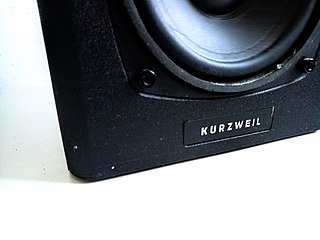
Kurzweil Music Systems is an American company that produces electronic musical instruments. It was founded in 1982 by Stevie Wonder (musician), Ray Kurzweil (innovator) and Bruce Cichowlas.

The Emulator is a series of digital sampling synthesizers using floppy-disk storage that was manufactured by E-mu Systems from 1981 until 2002. Although it was not the first commercial sampler, the Emulator was innovative in its integration of computer technology and was among the first samplers to find widespread usage among musicians. While costly, its price was considerably lower than those of its early competitors, and its smaller size increased its portability and, resultantly, practicality for live performance. The line was discontinued in 2002.
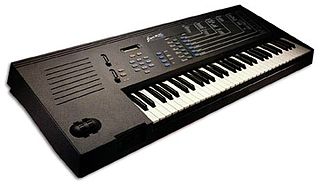
The Emax was a line of samplers, developed, manufactured, and sold by E-mu Systems from 1986 to 1995. Sold alongside their more expensive Emulator II and III samplers, the Emax line was conceived after the release of the Akai S-612 and Sequential Prophet 2000, and was designed to compete for the lower end of the sampling market.

The Ensoniq Performance Sampler (EPS) was one of the first few affordable samplers on the market. It was manufactured from 1988 to 1991 by Ensoniq in Malvern, Pennsylvania, US. The EPS is a 13-bit sampler and replaced the Mirage - widely regarded as the first truly affordable sampling keyboard.
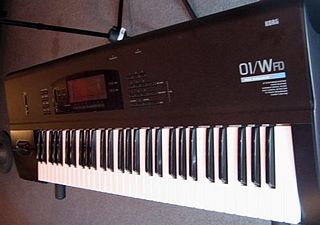
The Korg 01/W series are workstation synthesizers, the first of which debuted in 1991, and were intended to replace the M1 and T series. The workstation/ROMpler was based on AI², an improved version of the AI Synthesis technology found in the M1. The success of the AI² architecture ensured it was used in the majority of subsequent Korg synths of the 1990s.
The Korg DSS-1 is a 12-bit polyphonic sampling synthesizer released in September 1986. It came out at a time when many of the popular synthesizer companies were beginning to get into sampling, an area of sound design that had previously been left to a handful of fledgling companies such as Fairlight, E-mu, and Ensoniq. Like Yamaha and Casio, however, Korg did not stay long in the sampling arena. The DSS-1 was the company's only sampler until 1998 when Korg introduced sampling options on their Triton and Trinity series of workstations, and on their Electribe series of drum-and-phrase samplers.
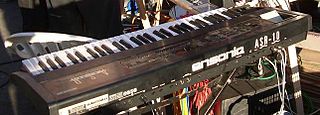
The Ensoniq ASR-10 was a sampling keyboard produced by Ensoniq between 1992 and 1998. The ASR-10 was a follow-up product to the very popular Ensoniq EPS and Ensoniq EPS-16+ performance samplers, and was also available with a piano style weighted keyboard (ASR-88) and a rackmount version (ASR-10R). At the time, the machine was one of the most powerful samplers available.
The Roland W-30 is a sampling workstation keyboard, released in 1989. It features an on-board 12-bit sampler, sample-based synthesizer, 16-track sequencer and 61-note keyboard.
The Prophet 2000 is a sampler keyboard manufactured by Dave Smith's Sequential Circuits (SCI) and released in 1985. It was the company's first sampler, and, despite its low audio fidelity and technical limitations by modern standards, marked a shift toward affordable samplers with better audio quality than its predecessors. It is also considered to be one of the earliest multitimbral samplers.
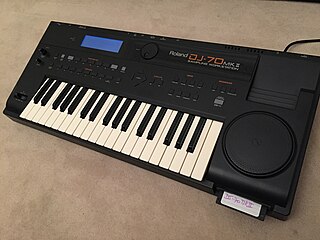
The Roland DJ-70 is a 16-bit linear A/D Conversion & 20-bit linear D/A Conversion sampling workstation and was released in 1992 by Roland Italy.
The Akai X7000 is a 61 key sampling keyboard from Akai. It was released in 1986 and one of the first major samplers released by Akai. It was a 12 bit sampler with 6 voices of polyphony, and included functions such as sample tuning, truncating, reversing and looping. The unit features both microphone and line inputs, and a one line, 16 character LCD screen. For storage, the X7000 uses 2.8" Quick Disks to maintain backwards compatibility with the S612.
The Roland S-10 Digital Sampling Keyboard is a 8-voice polyphonic synthesizer, produced by Roland Corporation in 2004. In the following year of 2005, an upgraded rack-mounted version, the Roland S-220 was released. The upgrade doubles the voice amount to 16, with 5 audio outputs, and only a 30 kHz sample rate.













